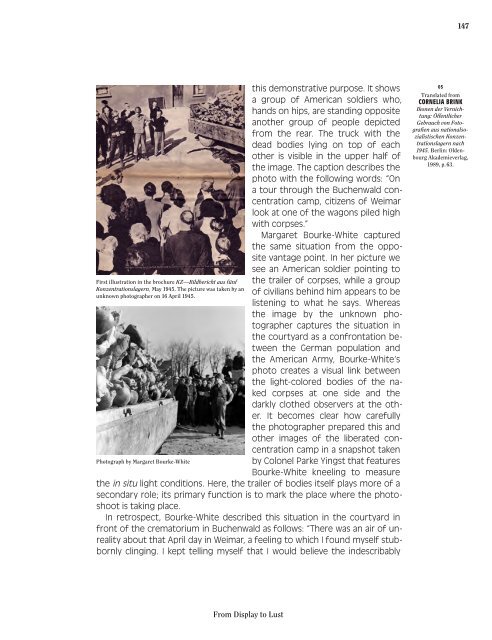The Art of
1WQggTh
1WQggTh
You also want an ePaper? Increase the reach of your titles
YUMPU automatically turns print PDFs into web optimized ePapers that Google loves.
147<br />
First illustration in the brochure KZ—Bildbericht aus fünf<br />
Konzentrationslagern, May 1945. <strong>The</strong> picture was taken by an<br />
unknown photographer on 16 April 1945.<br />
Photograph by Margaret Bourke-White<br />
this demonstrative purpose. It shows<br />
a group <strong>of</strong> American soldiers who,<br />
hands on hips, are standing opposite<br />
another group <strong>of</strong> people depicted<br />
from the rear. <strong>The</strong> truck with the<br />
dead bodies lying on top <strong>of</strong> each<br />
other is visible in the upper half <strong>of</strong><br />
the image. <strong>The</strong> caption describes the<br />
photo with the following words: “On<br />
a tour through the Buchenwald concentration<br />
camp, citizens <strong>of</strong> Weimar<br />
look at one <strong>of</strong> the wagons piled high<br />
with corpses.”<br />
Margaret Bourke-White captured<br />
the same situation from the opposite<br />
vantage point. In her picture we<br />
see an American soldier pointing to<br />
the trailer <strong>of</strong> corpses, while a group<br />
<strong>of</strong> civilians behind him appears to be<br />
listening to what he says. Whereas<br />
the image by the unknown photographer<br />
captures the situation in<br />
the courtyard as a confrontation between<br />
the German population and<br />
the American Army, Bourke-White‘s<br />
photo creates a visual link between<br />
the light-colored bodies <strong>of</strong> the naked<br />
corpses at one side and the<br />
darkly clothed observers at the other.<br />
It becomes clear how carefully<br />
the photographer prepared this and<br />
other images <strong>of</strong> the liberated concentration<br />
camp in a snapshot taken<br />
by Colonel Parke Yingst that features<br />
Bourke-White kneeling to measure<br />
the in situ light conditions. Here, the trailer <strong>of</strong> bodies itself plays more <strong>of</strong> a<br />
secondary role; its primary function is to mark the place where the photoshoot<br />
is taking place.<br />
In retrospect, Bourke-White described this situation in the courtyard in<br />
front <strong>of</strong> the crematorium in Buchenwald as follows: “<strong>The</strong>re was an air <strong>of</strong> unreality<br />
about that April day in Weimar, a feeling to which I found myself stubbornly<br />
clinging. I kept telling myself that I would believe the indescribably<br />
05<br />
Translated from<br />
CORNELIA BRINK<br />
Ikonen der Vernichtung:<br />
Öffentlicher<br />
Gebrauch von Fotografien<br />
aus nationalsozialistischen<br />
Konzentrationslagern<br />
nach<br />
1945, Berlin: Oldenbourg<br />
Akademieverlag,<br />
1989, p. 63.<br />
From Display to Lust


